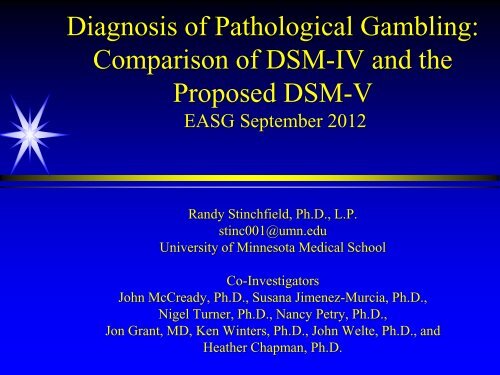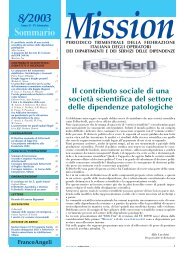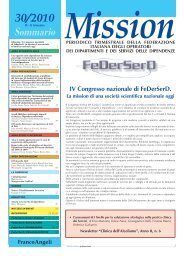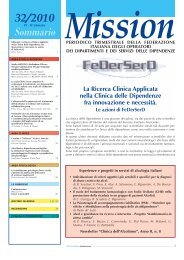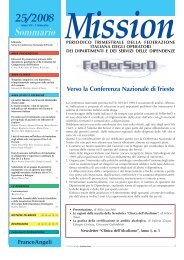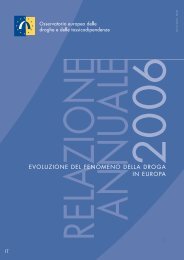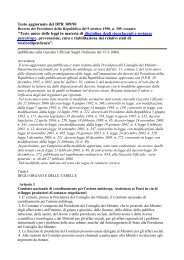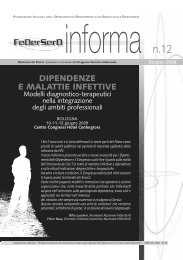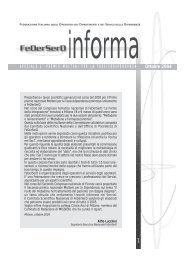Diagnosis of Pathological Gambling: Comparison of DSM-IV and the ...
Diagnosis of Pathological Gambling: Comparison of DSM-IV and the ...
Diagnosis of Pathological Gambling: Comparison of DSM-IV and the ...
- No tags were found...
You also want an ePaper? Increase the reach of your titles
YUMPU automatically turns print PDFs into web optimized ePapers that Google loves.
<strong>Diagnosis</strong> <strong>of</strong> <strong>Pathological</strong> <strong>Gambling</strong>:<strong>Comparison</strong> <strong>of</strong> <strong>DSM</strong>-<strong>IV</strong> <strong>and</strong> <strong>the</strong>Proposed <strong>DSM</strong>-VEASG September 2012R<strong>and</strong>y Stinchfield, Ph.D., L.P.stinc001@umn.eduUniversity <strong>of</strong> Minnesota Medical SchoolCo-InvestigatorsJohn McCready, Ph.D., Susana Jimenez-Murcia, Ph.D.,Nigel Turner, Ph.D., Nancy Petry, Ph.D.,Jon Grant, MD, Ken Winters, Ph.D., John Welte, Ph.D., <strong>and</strong>Hea<strong>the</strong>r Chapman, Ph.D.
AcknowledgementsStudy funded by Ontario Problem <strong>Gambling</strong>Research CentreMinnesota Lottery Director challenged <strong>the</strong>accuracy <strong>of</strong> <strong>the</strong> SOGS <strong>and</strong> this challengeinitiated my work in gambling measurementI started with <strong>the</strong> SOGS <strong>and</strong> <strong>the</strong>n thought, “Whyask 20 SOGS questions to predict <strong>DSM</strong>-<strong>IV</strong>diagnosis when you can ask 10 questions to geta <strong>DSM</strong>-<strong>IV</strong> diagnosis?”
<strong>Diagnosis</strong> <strong>of</strong> <strong>Pathological</strong> <strong>Gambling</strong>‣ <strong>Pathological</strong> <strong>Gambling</strong> (PG) was formallyrecognized as a mental disorder by <strong>the</strong> AmericanPsychiatric Association in 1980 in <strong>the</strong> third edition<strong>of</strong> <strong>the</strong> Diagnostic <strong>and</strong> Statistics Manual (<strong>DSM</strong>-III).‣ The diagnostic criteria for PG have been revisedtwice since <strong>the</strong>n (1987 <strong>and</strong> 1994) <strong>and</strong> <strong>the</strong> currentst<strong>and</strong>ard is <strong>DSM</strong>-<strong>IV</strong> (1994)‣ Proposed <strong>DSM</strong>-V includes some changes to PG
<strong>DSM</strong>-<strong>IV</strong> is <strong>the</strong> st<strong>and</strong>ard fordiagnosing PG but . . .‣ Drs. Lesieur <strong>and</strong> Rosenthal (1991) did a literature reviewfor <strong>the</strong> <strong>DSM</strong>-<strong>IV</strong> committee <strong>and</strong> found little data on <strong>the</strong>validity <strong>and</strong> classification accuracy <strong>of</strong> <strong>DSM</strong>-III-R criteriao<strong>the</strong>r than clinician opinions <strong>and</strong> anecdotal reports‣ <strong>DSM</strong> criteria for PG was developed by a committee <strong>of</strong>experts that had little guidance from empirical research‣ As Dr. Paul Meehl has noted, “Truth by committee isinitially unavoidable, but we should not persist in that.”‣ <strong>DSM</strong>-<strong>IV</strong> is <strong>the</strong> accepted st<strong>and</strong>ard <strong>and</strong> many instruments arebased on it (e.g., SCID, DIS, CIDI, AUDADIS, MAGS,GAMTOMS, DIGS, GAM-<strong>IV</strong>, <strong>DSM</strong>-<strong>IV</strong>-J <strong>and</strong> <strong>DSM</strong>-<strong>IV</strong>-MR-J, NODS, CPGI)
Which buffalo has Brucellosis?You can’t tell by looking at <strong>the</strong>m
And you cannot tell which person is a<strong>Pathological</strong> Gambler by watching <strong>the</strong>m playslots
Which person is a <strong>Pathological</strong> Gambler?You can’t tell by watching <strong>the</strong>m play Blackjack
<strong>DSM</strong>-<strong>IV</strong> Diagnostic CriteriaCut score <strong>of</strong> 5 out <strong>of</strong> 10‣ (1) Preoccupied with gambling‣ (2) Needs to gamble with increasing amounts <strong>of</strong> money‣ (3) Repeated unsuccessful efforts to control, cut back, or stop‣ (4) Restless or irritable when attempting to cut down or stop‣ (5) Gambles as a way <strong>of</strong> escaping problems or dysphoric mood‣ (6) “Chasing” losses‣ (7) Lies to conceal <strong>the</strong> extent <strong>of</strong> involvement with gambling‣ (8) Committed illegal acts to finance gambling‣ (9) Jeopardized or lost a relationship or job‣ (10) Relies on o<strong>the</strong>rs to provide money to relieve a desperate financialsituation (bail out)
What questions do you ask toidentify a <strong>Pathological</strong> Gambler?‣ You only have to ask two questions:‣ 1) Are you a pathological gambler?‣ 2) Did you lie (see Criterion #7) when youanswered <strong>the</strong> first question?
Proposed changes for PG in<strong>DSM</strong>-V (www.dsm5.org)‣ 1) Change <strong>the</strong> name from <strong>Pathological</strong> <strong>Gambling</strong> to Disordered<strong>Gambling</strong>‣ 2) Reclassify <strong>the</strong> disorder from Impulse-Control Disorders NotElsewhere Classified to Substance-Related Disorders which will berenamed Addiction <strong>and</strong> Related Disorders;‣ 3) Eliminate <strong>the</strong> criterion, “has committed illegal acts such as forgery,fraud, <strong>the</strong>ft, or embezzlement to finance gambling”‣ 4) Lower threshold for diagnosis from five to four criteria‣ 5) Specified time period; symptoms must be present during a 12month time period
Rationale for proposed lowering<strong>of</strong> threshold (www.dsm5.org)‣ Lower threshold for diagnosis from five to four criteria‣ Rationale: Three studies showed evidence that a cut score <strong>of</strong> four is more accuratethan a cut score <strong>of</strong> five‣ Stinchfield, R. (2003). Reliability, validity, <strong>and</strong> classification accuracy <strong>of</strong> a measure<strong>of</strong> <strong>DSM</strong>-<strong>IV</strong> diagnostic criteria for <strong>Pathological</strong> <strong>Gambling</strong>. American Journal <strong>of</strong>Psychiatry, 160, 180-182.‣ Stinchfield, R., Govoni, R., & Frisch, R. G. (2005). <strong>DSM</strong>-<strong>IV</strong> diagnostic criteria for<strong>Pathological</strong> <strong>Gambling</strong>: Reliability, validity, <strong>and</strong> classification accuracy. AmericanJournal on Addictions, 14, 73-82.‣ Jimenez-Murcia, S., Stinchfield, R., Alvarez-Moya, E., Jaurrieta, N., Bueno, B.,Granero, R., Aymami, M.N., Gomez-Pena, M., Gimenez-Martinez, R., Fern<strong>and</strong>ez-Ar<strong>and</strong>a, F., & Vallejo, J. (2009). Reliability, validity <strong>and</strong> classification accuracy <strong>of</strong> aSpanish translation <strong>of</strong> a measure <strong>of</strong> <strong>DSM</strong>-<strong>IV</strong> diagnostic criteria for pathologicalgambling. Journal <strong>of</strong> <strong>Gambling</strong> Studies, 25(1), 93-104.
Rationale for proposed elimination<strong>of</strong> illegal acts criterion‣ Eliminate <strong>the</strong> criterion, “has committed illegal actssuch as forgery, fraud, <strong>the</strong>ft, or embezzlement t<strong>of</strong>inance gambling”‣ Rationale: low prevalence criterion;One study suggested it could be eliminated‣ Strong, D. R., Kahler, C. W. (2007). Evaluation <strong>of</strong><strong>the</strong> continuum <strong>of</strong> gambling problems using <strong>the</strong><strong>DSM</strong>-<strong>IV</strong>. Addiction 102:713-721.
Research Questions‣ What is <strong>the</strong> reliability, validity, <strong>and</strong> classificationaccuracy <strong>of</strong> <strong>the</strong> proposed revision in <strong>DSM</strong>-V?‣ Is <strong>the</strong> proposed <strong>DSM</strong>-V more accurate than <strong>DSM</strong>-<strong>IV</strong>?‣ What is <strong>the</strong> impact on classification accuracy <strong>of</strong>each <strong>of</strong> <strong>the</strong> two proposed revisions for <strong>DSM</strong>-V?
Classification Accuracy:What is our Reference St<strong>and</strong>ard?‣ In order to compute classification accuracy a reference or “gold”st<strong>and</strong>ard is required. However, <strong>the</strong>re is no biological marker or labtest to serve as a reference st<strong>and</strong>ard for <strong>the</strong> diagnosis <strong>of</strong> PG‣ Group membership can be used as a proxy for a reference st<strong>and</strong>ard,that is, one group with PG (e.g., gambling treatment sample) <strong>and</strong> onegroup without PG (e.g., community sample)‣ Group membership is not perfect, because <strong>the</strong>re will be a few PGs in acommunity sample <strong>and</strong> <strong>the</strong>re may be some gambling treatment clientswho exhibit low gambling problem severity‣ Group membership is not a “gold” st<strong>and</strong>ard, but maybe “silver”
Sample; with group membership asreference st<strong>and</strong>ard‣ Data was recently collected from January 2011to July 2012‣ 1) PGs in treatment or GA fromOntario (n = 190) <strong>and</strong> Minnesota (n = 92)(total n = 282)‣ 2) Community members from Ontario(n = 219) <strong>and</strong> Minnesota (n = 116)(total n = 335)
Reliability <strong>and</strong> Factor Analysis for<strong>DSM</strong>-<strong>IV</strong> <strong>and</strong> <strong>DSM</strong>-V (n = 617)ReliabilityIndices <strong>DSM</strong>-<strong>IV</strong> <strong>DSM</strong>-VCronbach’sAlpha .95 .95Eigen value 6.7 6.4Varianceaccountedfor67% 71%
Reliability <strong>and</strong> Factor Analysis <strong>of</strong> <strong>DSM</strong>-<strong>IV</strong>Combined Ontario <strong>and</strong> Minnesota samples (n=617)Scale Alpha = .95Corrected Alpha if Factor<strong>DSM</strong>-<strong>IV</strong> CriteriaItem-to-total r item deleted loading8. Illegal acts .53 .95 .591. Preoccupied .71 .94 .772. Larger bets .81 .94 .853. Control or cut back .85 .94 .894. Restless or irritable .88 .93 .915. Escape .83 .94 .876. Chasing .78 .94 .837. Lied .85 .94 .899. Risked or lost relationship .72 .94 .7710. Relied on o<strong>the</strong>rs to pay debts .74 .94 .79
Classification Accuracy:Indices <strong>and</strong> Definitions‣ Classification accuracy indicates how well a scale identifies those with, <strong>and</strong> without,<strong>the</strong> disorder‣ Hit rate is <strong>the</strong> total correct classifications, that is, both true positives <strong>and</strong> truenegatives, out <strong>of</strong> all cases‣ Sensitivity is <strong>the</strong> true positive rate, that is, <strong>the</strong> rate <strong>of</strong> positive test results amongthose with <strong>the</strong> disorder‣ Specificity is <strong>the</strong> true negative rate, that is, <strong>the</strong> rate <strong>of</strong> negative test results amongthose without <strong>the</strong> disorder‣ False positive rate is <strong>the</strong> percent <strong>of</strong> positive test results among those without <strong>the</strong>disorder (error <strong>of</strong> saying someone has <strong>the</strong> disorder when <strong>the</strong>y do not have <strong>the</strong>disorder)‣ False negative rate is <strong>the</strong> percent <strong>of</strong> negative test results among those with <strong>the</strong>disorder (error <strong>of</strong> saying someone does not have <strong>the</strong> disorder when <strong>the</strong>y have <strong>the</strong>disorder)‣ Positive Predictive Power is <strong>the</strong> percent <strong>of</strong> true positives among those with positivetest results‣ Negative Predictive Power is <strong>the</strong> percent <strong>of</strong> true negatives among those withnegative test results
Classification Accuracy:Indices <strong>and</strong> DefinitionsTest ResultDisorder StatusPresentAbsentPositive True Positive False PositiveNegativeFalse Negative True Negative‣ Base rate = Disorder Present/all Ss‣ Hit rate = True Results/all Ss‣ Sensitivity = True Positives/Disorder Present‣ Specificity = True Negatives/Disorder Absent‣ False positive rate = False Positives/Disorder Absent‣ False negative rate = False Negatives/Disorder Present‣ Pos. Predictive Power = True Positives/all Positives‣ Neg. Predictive Power = True Negatives/all Negatives
Eliminating Illegal Acts CriterionAnalyses:‣ 1) endorsement rates <strong>of</strong> illegal acts criterion‣ 2) relative strength <strong>of</strong> illegal acts criterion tocorrectly classify cases from a DiscriminantFunction Analysis‣ 3) impact <strong>of</strong> elimination <strong>of</strong> illegal actscriterion on classification accuracy
Endorsement rates <strong>of</strong> <strong>DSM</strong>-<strong>IV</strong> criteriaCombined Ontario <strong>and</strong> Minnesota samples (n=617)UCDFC = Unst<strong>and</strong>ardized Canonical Discriminant Function Coefficient<strong>DSM</strong>-<strong>IV</strong> CriteriaPG(n = 282)Community(n = 335) UCDFC8. Illegal acts 41 0 .291. Preoccupied 99 35 .092. Larger bets 92 14 .583. Control or cut back 95 13 .744. Restless or irritable 92 9 .205. Escape 92 9 1.306. Chasing 95 21 .367. Lied 92 7 1.589. Risked or lost relationship 67 1 .5210. Relied on o<strong>the</strong>rs to pay debts 72 2 .71
Effect <strong>of</strong> elimination <strong>of</strong> illegal acts criterion:Changed dx <strong>of</strong> only 1 person out <strong>of</strong> 617No change to classification accuracy indices<strong>DSM</strong>-<strong>IV</strong>Score Gam Tx Gen Pop Total5+ 273 19 292
Effect <strong>of</strong> lowering threshold from 5 to 4:Changed dx <strong>of</strong> 20 people out <strong>of</strong> 617<strong>DSM</strong>-<strong>IV</strong>Score Gam Tx Gen Pop Total5+ 273 19 292
Best Cut Score?Frequency Distribution <strong>of</strong> Community <strong>and</strong>Treatment sample <strong>DSM</strong>-<strong>IV</strong> scores (n=617)1801601401201008060402000 1 2 3 4 5 6 7 8 9 10CommunityTreatment
<strong>Comparison</strong> <strong>of</strong> <strong>DSM</strong>-<strong>IV</strong> to Proposed <strong>DSM</strong>-V:Changed dx <strong>of</strong> 20 people out <strong>of</strong> 617<strong>DSM</strong>-<strong>IV</strong>Score Gam Tx Gen Pop Total5+ 273 19 292
Classification Accuracy Indices for <strong>DSM</strong>-<strong>IV</strong><strong>and</strong> <strong>DSM</strong>-V (n = 617) Base rate = .46AccuracyIndices<strong>DSM</strong>-<strong>IV</strong>without illegal5+<strong>DSM</strong>-<strong>IV</strong>4+<strong>DSM</strong>-<strong>IV</strong><strong>DSM</strong>-VHit Rate .95 .94 .95 .94Sensitivity .96 .99 .97 .99Specificity .94 .90 .94 .90FPR .06 .10 .06 .10FNR .04 .01 .03 .01PPP .93 .89 .93 .89NPP .97 .99 .97 .99
Frequency Distribution <strong>of</strong> <strong>DSM</strong>-<strong>IV</strong> scores byGroup Membership (n = 617)<strong>DSM</strong>-<strong>IV</strong>ScorePG(n=282)Community(n=335)Probability <strong>of</strong> beingPG at each score0 0 168 .001 0 80 .002 3 35 .083 1 18 .054 5 15 .255 6 8 .436 13 9 .597 40 2 .958 55 0 1.009 89 0 1.0010 70 0 1.00
<strong>DSM</strong>-<strong>IV</strong> Score interpretation‣ There was an increasing probability <strong>of</strong> being amember <strong>of</strong> <strong>the</strong> PG with each increasing score‣ A score <strong>of</strong> 0, 1, 2, or 3 resulted in almost no chance<strong>of</strong> being in <strong>the</strong> PG sample‣ A score <strong>of</strong> 7, 8, 9, or 10 resulted in almost certainty<strong>of</strong> being in <strong>the</strong> PG sample‣ A score <strong>of</strong> 4, 5, or 6 resulted in about an equalchance <strong>of</strong> being in <strong>the</strong> PG sample, so <strong>the</strong>seindividuals may require fur<strong>the</strong>r assessment in orderto correctly classify
Conclusions‣ Illegal acts criterion can be eliminated without changingclassification accuracy‣ Lowering <strong>the</strong> threshold from 5 to 4 improves classificationaccuracy for <strong>the</strong> most serious classification error <strong>of</strong> FalseNegative Rate‣ <strong>DSM</strong>-V demonstrated evidence <strong>of</strong> satisfactory reliability‣ <strong>DSM</strong>-V demonstrated slight improvements in classificationaccuracy over <strong>DSM</strong>-<strong>IV</strong> in Sensitivity <strong>and</strong> FNR‣ The changes in classification accuracy indices are dueprimarily to <strong>the</strong> reduced cut score ra<strong>the</strong>r than <strong>the</strong>elimination <strong>of</strong> <strong>the</strong> illegal acts criterion
Future Research Directions‣ Classification accuracy indices vary be population <strong>and</strong> setting (seeGambino), so future research should focus on measuring <strong>DSM</strong>-Vaccuracy in samples from a variety <strong>of</strong> populations <strong>and</strong> settings‣ Some items are better indicators <strong>of</strong> PG than o<strong>the</strong>rs <strong>and</strong> future researchshould identify <strong>the</strong> best items for a given sample/setting‣ Develop new diagnostic items . . . <strong>the</strong> search continues for <strong>the</strong> bestsigns <strong>and</strong> symptoms <strong>of</strong> PG‣ Test <strong>the</strong> use <strong>of</strong> item weights <strong>and</strong> cross-validate in o<strong>the</strong>r populations toensure <strong>the</strong>y generalize to o<strong>the</strong>r samples <strong>and</strong> are not unique to <strong>the</strong>sample from which <strong>the</strong>y were generated‣ Test <strong>the</strong> use <strong>of</strong> multiple response options, as is done with <strong>DSM</strong>-<strong>IV</strong>-MR-J <strong>and</strong> CPGI, ra<strong>the</strong>r than yes/no, to determine if this improvesclassification accuracy
For More Information‣ Contact Dr. R<strong>and</strong>y Stinchfield; stinc001@umn.edu‣ References:‣ Stinchfield, R. (2003). Reliability, validity, <strong>and</strong> classification accuracy <strong>of</strong> a measure<strong>of</strong> <strong>DSM</strong>-<strong>IV</strong> diagnostic criteria for <strong>Pathological</strong> <strong>Gambling</strong>. American Journal <strong>of</strong>Psychiatry, 160, 180-182.‣ Stinchfield, R. Govoni, R., & Frisch, R. G. (2005). <strong>DSM</strong>-<strong>IV</strong> diagnostic criteria for<strong>Pathological</strong> <strong>Gambling</strong>: Reliability, validity, <strong>and</strong> classification accuracy. AmericanJournal on Addictions, 14, 73-82.‣ Jimenez-Murcia, S., Stinchfield, R., Alvarez-Moya, E., Jaurrieta, N., Bueno, B.,Granero, R., Aymami, M.N., Gomez-Pena, M., Gimenez-Martinez, R., Fern<strong>and</strong>ez-Ar<strong>and</strong>a, F., & Vallejo, J. (2009). Reliability, validity <strong>and</strong> classification accuracy <strong>of</strong> aSpanish translation <strong>of</strong> a measure <strong>of</strong> <strong>DSM</strong>-<strong>IV</strong> diagnostic criteria for pathologicalgambling. Journal <strong>of</strong> <strong>Gambling</strong> Studies, 25(1), 93-104.


